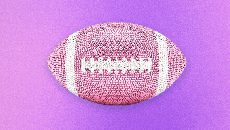Save 50% on a 3-month Digiday+ membership. Ends Dec 5.
What this year’s Super Bowl ads said about diversity, influencers and commerce

As a Digiday+ member, you were able to access this article early through the Digiday+ Story Preview email. See other exclusives or manage your account.This article was provided as an exclusive preview for Digiday+ members, who were able to access it early. Check out the other features included with Digiday+ to help you stay ahead
Super Bowl LVIII on CBS drew the biggest-ever single TV audience of more than 126 million this past Sunday, per iSpot – growing not just in viewership for football’s ultimate contest, but the advertising game as it continues to shape diversity, influencer marketing and commerce media.
The Kansas City Chiefs’ win over the San Francisco 49ers in overtime delivered an average second-by-second audience of 126.6 million across all linear, out-of-home and streaming, with CBS accounting for 36% of all TV ad impressions, according to preliminary data from iSpot. Viewership grew 10.9% year-over-year, with 81 spots from 65 advertisers – up from 59 spots and 51 advertisers in 2023.
Super Bowl advertising has continued to get more expensive — with a price tag of $7 million per ad this year — forcing agencies and clients to get strategic and creative about teasing their content on social media with a mix of influencers and celebrities, expanding retail opportunities — while also balancing diversity and representation.
Comparing DEI to the industry metrics
Ad platform XR Extreme Reach compared Super Bowl ads to overall advertising benchmarks, finding that this year’s ads featured more masculine gender expression compared to feminine and non-conforming roles: 59% of ads featured masculine expressions, compared to 41% feminine and 0.6% non-conforming. In previous reports, XR found more female cast members compared to the broader industry.
XR’s platform manages the creative assets and intelligence that is used to deliver more than 80% of all ads on this Super Bowl, including all of the digital ads and all of NFL’s ads.
Ad position: web_incontent_pos1
Analyzing 47 in-game advertisements using AI and machine learning, it also looked at skin tone, accessibility and age representation. Ads tended to cater to young adults – with more than 86% of those featured under the age of 40. The majority were between the ages of 20 to 39 (55.9%), but in-game ads represented more people over 40 – at 33%, compared to 14% across TV and video ads across the industry, according to the analysis.
However, this year’s game featured fewer people of color compared to previous Super Bowls and industry averages. People with lighter skin tones represented 57.7% of all featured talent, nearly double those with medium skin tones (28%). Dark skin tones were found in only 14.3% of content.
“This type of data is important for the industry as it provides a clear picture on where the gaps are in representation of racial and gender diversity – as well as differences in abilities as compared to the U.S. population – and helps marketers widen their aperture through the use of data to create more inclusive content,” said Sheryl Daija, founder and CEO of nonprofit DEI trade group Bridge.
One area of improvement revolved around accessibility, according to this analysis: 99.9% of in-game ads included closed captioning (only one ad was missing it), significantly higher compared to 33% of TV and video ads that typically have captions, per XR. About 11 million people in the U.S. alone are hard of hearing or functionally deaf.
Going beyond gameday
Ad position: web_incontent_pos2
Social media has become a top draw for advertisers and agencies promoting Super Bowl content in advance of and following the game. Whether ads feature influencers like Addison Rae and Charli D’Amelio or celebrities like Ben Affleck and Michael Cera, marketers are not only using a mix of talent, but pushing the content much earlier to build engagement. In the case of Rae’s Nerds candy ad, she was in the main pre-Super Bowl teasers on social media – but played a background role for the linear ad spot on CBS.
“This way, Gen Z can still be delighted by the fact that a creator like Addison Rae was featured at all, while the older audiences who aren’t familiar with her won’t be left confused and wondering, ‘Who was that? Am I supposed to know her?’” said Zach Honer, senior creative strategist at influencer agency Open Influence.
Watching the retail space
This year also saw retailers investing in the Super Bowl, including Chinese commerce company Temu for the second year.
“Brands that are investing in major Super Bowl advertising campaigns are trying to carry that experience into the retail media environment,” said Ethan Goodman, evp of global e-commerce and media at The Mars Agency. “Brands with competition airing major above-the-line Super Bowl campaigns are trying to steal the below-the-line opportunities on retail media networks by optimizing media and search for competitive conquesting.”
Temu topped this year’s 10 most talked about Super Bowl advertisers on social media with $817,442 in media value (Apple Music, which sponsored the halftime show featuring Usher and other artists, ranked No.1 with some $6.2 million in media value), according to influencer analytics platform WeArisma.
The investments seem to be paying off: Last year, after Temu’s half-time commercial the company saw user numbers rise from 8 million to 12.3 million in one month. The day after the 2023 Super Bowl, Temu saw record engagement with 210 million minutes spent on its app, according to consultancy GWS Magnify.
More in Media Buying

The Trade Desk loosens its grip on pricing amid buyer pressure
Amid fierce DSP competition, media agencies are finding The Trade Desk’s reps in a negotiating mood.

Criteo CEO Michael Komasinski on agentic commerce, experiments with LLMs, and M&A rumors
Criteo is not up for sale, although ‘no comment’ on potential divestment of assets, and how the future of ads in LLMs is (likely) native.

Ad Tech Briefing: The Programmatic Governance Council is a bid to reset power dynamics
As tensions over TID and GPID peak, Tech Lab is convening a council to hash out commercial ground rules.
Ad position: web_bfu





